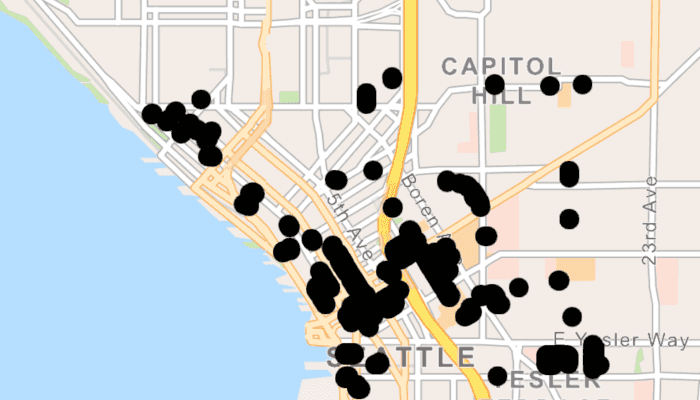Load a WFS feature table using an XML query.

Use case
Runtime QueryParameters objects can't represent all possible queries that can be made against a WFS feature service. For example, Runtime query parameters don't support wildcard searches. You can provide queries as raw XML strings, allowing you to access query functionality not available with QueryParameters.
How to use the sample
Run the sample and view the data loaded from the the WFS feature table.
How it works
- Create a
WfsFeatureTableand aFeatureLayerto visualize the table. - Set the feature request mode to
ManualCache. - Call
populateFromServiceAsync()to populate the table with only those features returned by the XML query.
Relevant API
- FeatureLayer
- WfsFeatureTable
- WfsFeatureTable.setAxisOrder()
- WfsFeatureTable.populateFromServiceAsync()
About the data
This service shows trees in downtown Seattle and the surrounding area. An XML-encoded GetFeature request is used to limit results to only trees of the genus Tilia.
For additional information, see the underlying service on ArcGIS Online.
Tags
feature, OGC, query, service, web, WFS, XML
Sample Code
/*
* Copyright 2019 Esri
*
* Licensed under the Apache License, Version 2.0 (the "License");
* you may not use this file except in compliance with the License.
* You may obtain a copy of the License at
*
* http://www.apache.org/licenses/LICENSE-2.0
*
* Unless required by applicable law or agreed to in writing, software
* distributed under the License is distributed on an "AS IS" BASIS,
* WITHOUT WARRANTIES OR CONDITIONS OF ANY KIND, either express or implied.
* See the License for the specific language governing permissions and
* limitations under the License.
*/
package com.esri.arcgisruntime.sample.wfsxmlquery;
import java.io.BufferedReader;
import java.io.IOException;
import java.io.InputStreamReader;
import android.os.Bundle;
import android.util.Log;
import android.widget.Toast;
import androidx.annotation.Nullable;
import androidx.appcompat.app.AppCompatActivity;
import com.esri.arcgisruntime.ArcGISRuntimeEnvironment;
import com.esri.arcgisruntime.concurrent.ListenableFuture;
import com.esri.arcgisruntime.data.FeatureQueryResult;
import com.esri.arcgisruntime.data.ServiceFeatureTable;
import com.esri.arcgisruntime.layers.FeatureLayer;
import com.esri.arcgisruntime.mapping.ArcGISMap;
import com.esri.arcgisruntime.mapping.BasemapStyle;
import com.esri.arcgisruntime.mapping.view.MapView;
import com.esri.arcgisruntime.ogc.wfs.OgcAxisOrder;
import com.esri.arcgisruntime.ogc.wfs.WfsFeatureTable;
public class MainActivity extends AppCompatActivity {
private static final String TAG = MainActivity.class.getSimpleName();
private MapView mMapView;
@Override protected void onCreate(@Nullable Bundle savedInstanceState) {
super.onCreate(savedInstanceState);
setContentView(R.layout.activity_main);
// authentication with an API key or named user is required to access basemaps and other
// location services
ArcGISRuntimeEnvironment.setApiKey(BuildConfig.API_KEY);
mMapView = findViewById(R.id.mapView);
// create a map and set the map to display in the map view
ArcGISMap map = new ArcGISMap(BasemapStyle.ARCGIS_NAVIGATION);
mMapView.setMap(map);
// create the WFS feature table from URL and name
WfsFeatureTable statesTable = new WfsFeatureTable(getString(R.string.wfs_feature_table_url),
getString(R.string.wfs_feature_table_table_name));
// set the feature request mode and axis order
statesTable.setAxisOrder(OgcAxisOrder.NO_SWAP);
statesTable.setFeatureRequestMode(ServiceFeatureTable.FeatureRequestMode.MANUAL_CACHE);
// create a feature layer to visualize the table.
FeatureLayer statesLayer = new FeatureLayer(statesTable);
// add the layer to the map.
mMapView.getMap().getOperationalLayers().add(statesLayer);
try {
String xmlQuery = loadQueryFromAssets();
ListenableFuture<FeatureQueryResult> featureQueryResultFuture = statesTable
.populateFromServiceAsync(xmlQuery, true);
featureQueryResultFuture.addDoneListener(() -> {
// set the viewpoint of the map view to the extent reported by the feature layer
mMapView.setViewpointGeometryAsync(statesLayer.getFullExtent(), 50);
});
} catch (IOException e) {
logErrorToUser(getString(R.string.error_reading_xml_file, e.getMessage()));
}
}
private void logErrorToUser(String error) {
Toast.makeText(this, error, Toast.LENGTH_SHORT).show();
Log.e(TAG, error);
}
private String loadQueryFromAssets() throws IOException {
StringBuilder xmlString = new StringBuilder();
BufferedReader bufferedReader = new BufferedReader(
new InputStreamReader(getAssets().open(getString(R.string.xml_query_file_name))));
String line;
while ((line = bufferedReader.readLine()) != null) {
xmlString.append(line);
}
bufferedReader.close();
return xmlString.toString();
}
@Override protected void onResume() {
super.onResume();
mMapView.resume();
}
@Override protected void onPause() {
mMapView.pause();
super.onPause();
}
@Override protected void onDestroy() {
mMapView.dispose();
super.onDestroy();
}
}